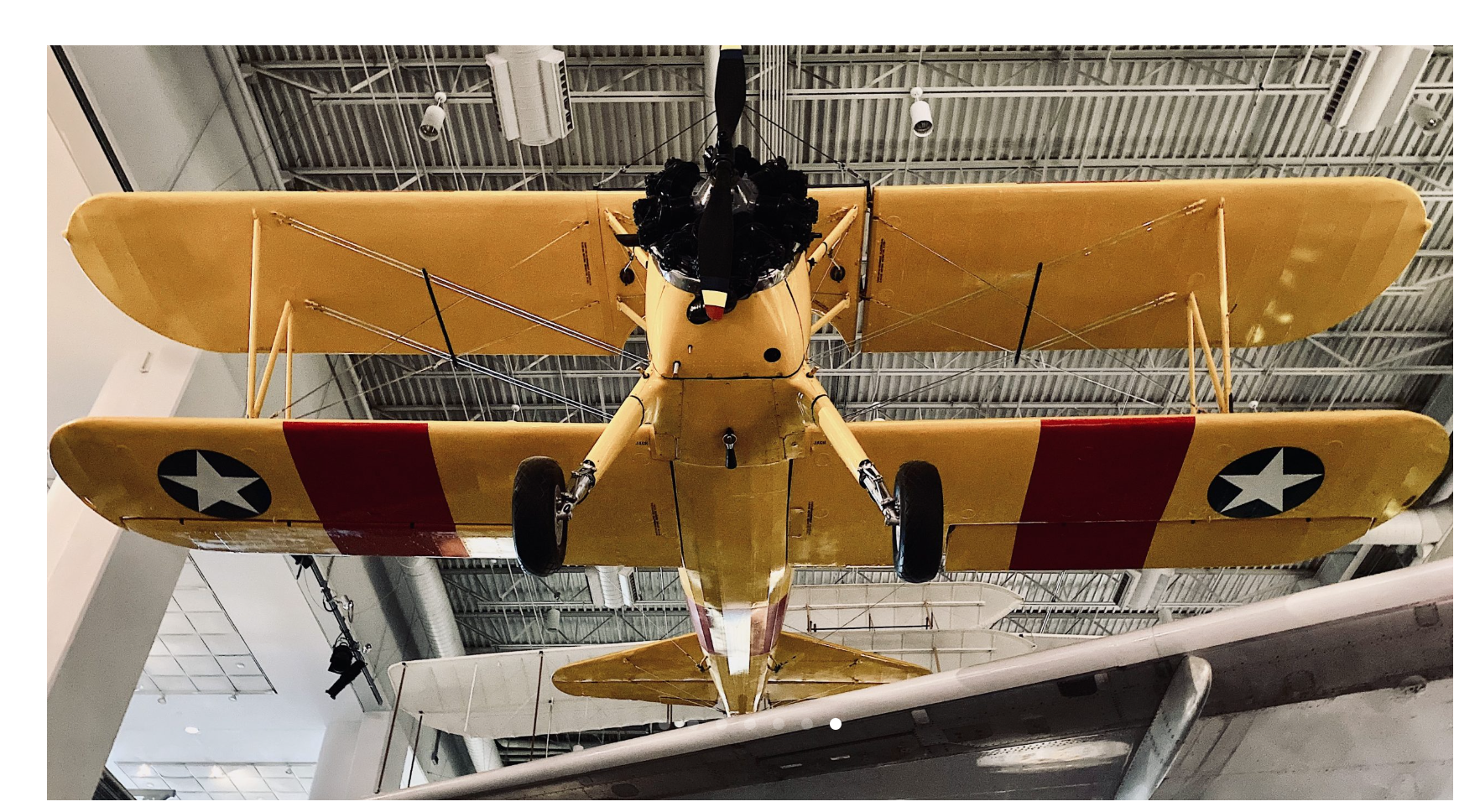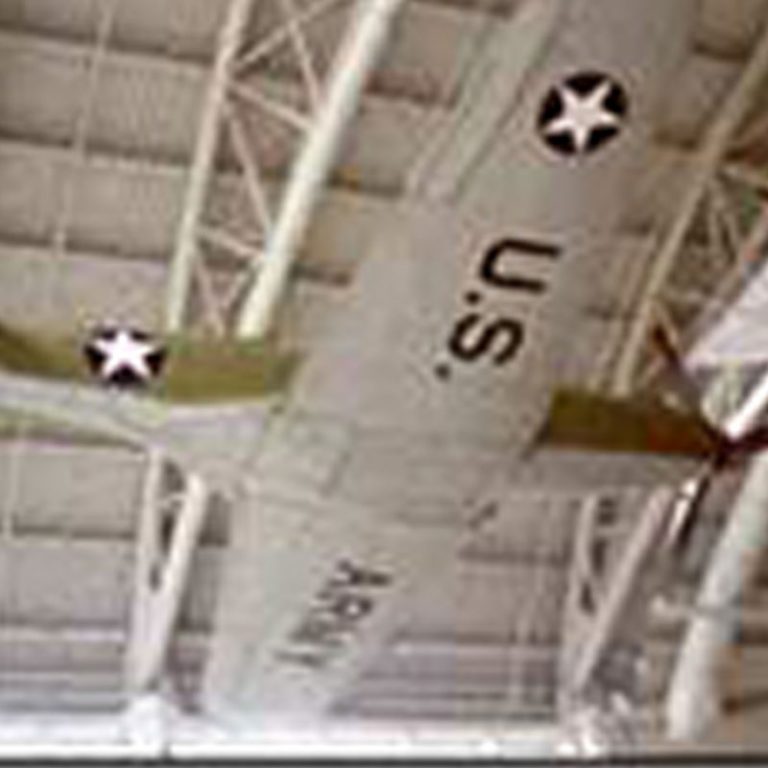

The Virginia Air & Space Science Center features a number of aircraft that highlight more than 100 years of aviation achievements. From a replica of the 1903 Wright Flyer to a full-size DC-9 passenger jet, the Center’s aircraft depict a number of aviation firsts and milestones.
 Bell P-39Q “Airacobra”
Bell P-39Q “Airacobra”
Convair F-106B “Delta Dart”
 The F-106 was produced as Mach-2 interceptors from 1956 to 1961 and were used by the U.S. Air Force to protect U.S. air space. Its coke bottle shape, developed at Langley Research Center, marks the revolutionary advancement in aircraft design that attributed to attaining supersonic speed in level flight. From 1980 to 1986, the F-106B on display was used for lightning research by NASA Langley Research Center and purposely flown into thunderstorms, being struck more than 700 times by lightning.
The F-106 was produced as Mach-2 interceptors from 1956 to 1961 and were used by the U.S. Air Force to protect U.S. air space. Its coke bottle shape, developed at Langley Research Center, marks the revolutionary advancement in aircraft design that attributed to attaining supersonic speed in level flight. From 1980 to 1986, the F-106B on display was used for lightning research by NASA Langley Research Center and purposely flown into thunderstorms, being struck more than 700 times by lightning.
DC-9 Passenger Jet
 The DC-9 is a twin-engine, single-aisle jet airliner designed specifically to operate from short runways and on short-to-medium range routes so that the speed and comfort of jet transportation could be extended to communities previously served by propeller-driven airlines.
The DC-9 is a twin-engine, single-aisle jet airliner designed specifically to operate from short runways and on short-to-medium range routes so that the speed and comfort of jet transportation could be extended to communities previously served by propeller-driven airlines.F-16 Nose Section
 The General Dynamics (now Lockheed Martin) F-16 Fighting Falcon is a single-engine multirole fighter aircraft originally developed by General Dynamics for the United States Air Force (USAF). Designed as an air superiority day fighter, it evolved into a successful all-weather multirole aircraft.The Fighting Falcon is a fighter with numerous innovations including a frameless bubble canopy for better visibility, side-mounted control stick to ease control while maneuvering, a seat reclined 30 degrees to reduce the effect of g-forces on the pilot, and the first use of a relaxed static stability/fly-by-wire flight control system helps to make it a nimble aircraft. Visitors can peer into the cockpit of this popular fighter for a look at modern-day military and the challenges pilots face.
The General Dynamics (now Lockheed Martin) F-16 Fighting Falcon is a single-engine multirole fighter aircraft originally developed by General Dynamics for the United States Air Force (USAF). Designed as an air superiority day fighter, it evolved into a successful all-weather multirole aircraft.The Fighting Falcon is a fighter with numerous innovations including a frameless bubble canopy for better visibility, side-mounted control stick to ease control while maneuvering, a seat reclined 30 degrees to reduce the effect of g-forces on the pilot, and the first use of a relaxed static stability/fly-by-wire flight control system helps to make it a nimble aircraft. Visitors can peer into the cockpit of this popular fighter for a look at modern-day military and the challenges pilots face.
Grumman-American Yankee Aircraft
 The Grumman-American Yankee was built in 1969 as a two-seat general aviation passenger plane. This Grumman-American Yankee was used between 1977 and 1987 for stall and spin tests conducted by NASA Langley Research Center. This aircraft, tail number SN 0001, was the first Grumman-Yankee ever built.
The Grumman-American Yankee was built in 1969 as a two-seat general aviation passenger plane. This Grumman-American Yankee was used between 1977 and 1987 for stall and spin tests conducted by NASA Langley Research Center. This aircraft, tail number SN 0001, was the first Grumman-Yankee ever built.
F-18 High Angle-of-Attack (Alpha) Research Vehicle “Harv”
 The F-18 HARV (High Alpha Research Vehicle), a former NASA research aircraft, was used to improve the safety and maneuverability of modern military fighters in combat situations. Flight research with the HARV increased our understanding of flight at high angles of attack, helping makers of U.S fighter jets design features that will make fighter jets safer to fly.
The F-18 HARV (High Alpha Research Vehicle), a former NASA research aircraft, was used to improve the safety and maneuverability of modern military fighters in combat situations. Flight research with the HARV increased our understanding of flight at high angles of attack, helping makers of U.S fighter jets design features that will make fighter jets safer to fly.
UH-1M Iroquois “Huey” Helicopter
 The “Huey” is a military helicopter powered by a single turboshaft engine, with a two-bladed main rotor and tail rotor. It was used for transporting personnel and equipment, medical evacuation, and reconnaissance and security duty during the Vietnam War.
The “Huey” is a military helicopter powered by a single turboshaft engine, with a two-bladed main rotor and tail rotor. It was used for transporting personnel and equipment, medical evacuation, and reconnaissance and security duty during the Vietnam War.
Hawker Siddeley XV-6A Kestrel, NASA Tail 521
 The aircraft was used as a research aircraft by the NASA Langley Research Center from 1968 to 1974. The successful demonstration of the Kestrel led to the development of the “Harrier,” the world’s first operational vertical take-off and landing jet fighter.
The aircraft was used as a research aircraft by the NASA Langley Research Center from 1968 to 1974. The successful demonstration of the Kestrel led to the development of the “Harrier,” the world’s first operational vertical take-off and landing jet fighter.
Kitfox Model 4 Speedster
 Manufactured as a Home-Built Kit Plane by Skystar Aircraft Corporation of Nampa, Idaho and donated to the Virginia Air & Space Center by Cliff and Edna Allison in 1998. This two-seater, featuring a three-blade 68-inch propeller and full-length flaperons, has an empty weight of 750 pounds and a gross weight capacity of 1200 pounds.
Manufactured as a Home-Built Kit Plane by Skystar Aircraft Corporation of Nampa, Idaho and donated to the Virginia Air & Space Center by Cliff and Edna Allison in 1998. This two-seater, featuring a three-blade 68-inch propeller and full-length flaperons, has an empty weight of 750 pounds and a gross weight capacity of 1200 pounds.B-24D “Liberator” Nose Section
 Manufactured by Consolidated Aviation during WW II, the “Liberator” was built in greater number than any other American combat aircraft, over 19,000. The heavy bomber is 66′ 4″ inches long, has a wingspan of 110 feet, and an empty weight of approximately 25,000 pounds. The B-24D was the first variant to be mass-produced.
Manufactured by Consolidated Aviation during WW II, the “Liberator” was built in greater number than any other American combat aircraft, over 19,000. The heavy bomber is 66′ 4″ inches long, has a wingspan of 110 feet, and an empty weight of approximately 25,000 pounds. The B-24D was the first variant to be mass-produced.
Pershing II Missile
 The Pershing II is a solid propellant, terminally guided, two-stage medium-range ballistic missile capable of carrying a nuclear warhead. The Pershing II’s Soviet counterpart SS-20 was almost 20 feet taller, could go three times as far, and dispatch three separate warheads. The Pershing II and Soviet SS-20 have been eliminated under the terms of the Intermediate-Range Nuclear Forces Treaty (INF). The Pershing II is considered the most accurate and deadly of the missiles banned by the INF Treaty.
The Pershing II is a solid propellant, terminally guided, two-stage medium-range ballistic missile capable of carrying a nuclear warhead. The Pershing II’s Soviet counterpart SS-20 was almost 20 feet taller, could go three times as far, and dispatch three separate warheads. The Pershing II and Soviet SS-20 have been eliminated under the terms of the Intermediate-Range Nuclear Forces Treaty (INF). The Pershing II is considered the most accurate and deadly of the missiles banned by the INF Treaty.F-4E “Phantom II”
 The F-4E is a tandem two-seat, twin-engine, all-weather, long-range supersonic jet interceptor fighter/fighter-bomber. During the Vietnam War the F-4 was used extensively; it served as the principal air superiority fighter for both the Navy and Air Force, and became important in the ground-attack and reconnaissance roles late in the war. The aircraft traveled faster than Mach-2 at 40,000 feet and could carry over 18,000 pounds of weapons. The aircraft on display scored two MIG kills during the Vietnam War.
The F-4E is a tandem two-seat, twin-engine, all-weather, long-range supersonic jet interceptor fighter/fighter-bomber. During the Vietnam War the F-4 was used extensively; it served as the principal air superiority fighter for both the Navy and Air Force, and became important in the ground-attack and reconnaissance roles late in the war. The aircraft traveled faster than Mach-2 at 40,000 feet and could carry over 18,000 pounds of weapons. The aircraft on display scored two MIG kills during the Vietnam War.
Piper J-3 Cub
 The Piper J-3Cub was manufactured by the Piper Aircraft Corporation under the direction of William T. Piper. Mr. Piper has often been referred to as the “Henry Ford of Aviation” because it was his Piper Cub that put the common man in the air, much like Ford’s Model T put man on the road.
The Piper J-3Cub was manufactured by the Piper Aircraft Corporation under the direction of William T. Piper. Mr. Piper has often been referred to as the “Henry Ford of Aviation” because it was his Piper Cub that put the common man in the air, much like Ford’s Model T put man on the road.Pitts Special
 Originally built by Curtiss Pitts in 1943, the “Special” was a minor type until the early 1960’s. The Pitts Special was the first line of aerobatic type aircraft and considered the most popular single engine plane among amateur builders in the United States.
Originally built by Curtiss Pitts in 1943, the “Special” was a minor type until the early 1960’s. The Pitts Special was the first line of aerobatic type aircraft and considered the most popular single engine plane among amateur builders in the United States.Stearman N2S-3 Trainer
 This trainer was built for the Navy and Marine Corps between 1936 and 1939. Over 10,000 of the various models of the aircraft were produced by the end of WWII. Thousands of pilots received their initial flight instruction in “Stearmans” which were considered ideal for teaching basic flying maneuvers, aerobatics, and takeoffs.
This trainer was built for the Navy and Marine Corps between 1936 and 1939. Over 10,000 of the various models of the aircraft were produced by the end of WWII. Thousands of pilots received their initial flight instruction in “Stearmans” which were considered ideal for teaching basic flying maneuvers, aerobatics, and takeoffs.
F-104C “Starfighter”
 The “Starfighter” is a single-engine, high-performance, supersonic interceptor aircraft originally developed for the United States Air Force (USAF) by Lockheed. One of the Century Series of aircraft, it was operated by the air forces of more than a dozen nations from 1958 to 2004. It was nicknamed “the missile with a man in it” since its long, thin fuselage and stubby wings resemble a missile. It was the first interceptor in our nation’s service to fly at sustained speeds above Mach-2.
The “Starfighter” is a single-engine, high-performance, supersonic interceptor aircraft originally developed for the United States Air Force (USAF) by Lockheed. One of the Century Series of aircraft, it was operated by the air forces of more than a dozen nations from 1958 to 2004. It was nicknamed “the missile with a man in it” since its long, thin fuselage and stubby wings resemble a missile. It was the first interceptor in our nation’s service to fly at sustained speeds above Mach-2.
Schleicher ASW-12 Glider
 The Schleicher ASW-12 Glider is the production version of the famous D-36, which won the 1964 German Nationals. Generally conceded to be the highest-performance sailplane in the world, until the advent of the Nimbus prototype and the Glasflugel 604 in 1970, it is still a formidable plane.
The Schleicher ASW-12 Glider is the production version of the famous D-36, which won the 1964 German Nationals. Generally conceded to be the highest-performance sailplane in the world, until the advent of the Nimbus prototype and the Glasflugel 604 in 1970, it is still a formidable plane.
Rutan Vari-Ez Aircraft
 The Rutan Vari-Ez was designed by Burt Rutan, the designer of the famous Voyager airplane, the first airplane to fly non-stop around the world on one tank of gas. The Vari-Ez was one of Rutan’s first composite designs to take hold amongst home-built aviation enthusiasts.
The Rutan Vari-Ez was designed by Burt Rutan, the designer of the famous Voyager airplane, the first airplane to fly non-stop around the world on one tank of gas. The Vari-Ez was one of Rutan’s first composite designs to take hold amongst home-built aviation enthusiasts.
Replica 1903 Wright Flyer
 Commissioned by the Virginia Air & Space Science Center and built by Arizona Models in 97 days, the replica 1903 Wright Flyer was the first flyer in the United States to be completed for the Centennial of Flight. The original Wright Flyer is known for achieving the “first flight” at Kitty Hawk, North Carolina, on December 17, 1903. An accurate reproduction of the first powered airplane this replica is within 21 lbs. of the original Wright Flyer.
Commissioned by the Virginia Air & Space Science Center and built by Arizona Models in 97 days, the replica 1903 Wright Flyer was the first flyer in the United States to be completed for the Centennial of Flight. The original Wright Flyer is known for achieving the “first flight” at Kitty Hawk, North Carolina, on December 17, 1903. An accurate reproduction of the first powered airplane this replica is within 21 lbs. of the original Wright Flyer.
F-84 Thunderstreak
 The F-84 was contemporary with the popular swept-wing F-86 Sabre. Conceived in late 1949, a standard F-84E fuselage was mated to a pair of wings swept back. The horizontal and vertical surfaces were also swept back. Unfortunately, despite its name, the aircraft reached a top speed of only 658 mph, far below Air Force requirements.
The F-84 was contemporary with the popular swept-wing F-86 Sabre. Conceived in late 1949, a standard F-84E fuselage was mated to a pair of wings swept back. The horizontal and vertical surfaces were also swept back. Unfortunately, despite its name, the aircraft reached a top speed of only 658 mph, far below Air Force requirements.YF-16 “Fighting Falcon”
 The YF-16 was developed by a team of General Dynamics engineers led by Robert H. Widmer. The first YF-16 was rolled out on 13 December 1973, and its 90-minute maiden flight was made at the Air Force Flight Test Center (AFFTC) at Edwards AFB, California, on 2 February 1974.The YF-16 was a no-frills service-test prototype and differed from subsequent F-16’s in having no weapons or radar, thus being lighter with its center of gravity further forward, affording greater maneuverability.
The YF-16 was developed by a team of General Dynamics engineers led by Robert H. Widmer. The first YF-16 was rolled out on 13 December 1973, and its 90-minute maiden flight was made at the Air Force Flight Test Center (AFFTC) at Edwards AFB, California, on 2 February 1974.The YF-16 was a no-frills service-test prototype and differed from subsequent F-16’s in having no weapons or radar, thus being lighter with its center of gravity further forward, affording greater maneuverability.
